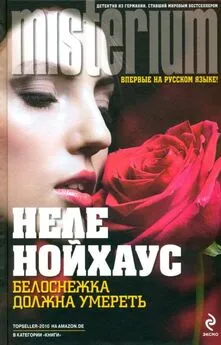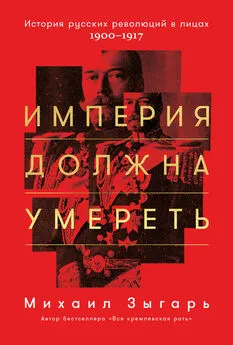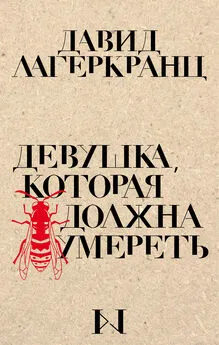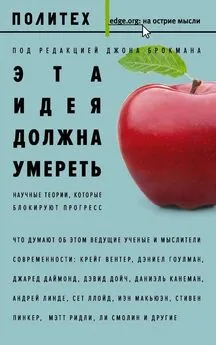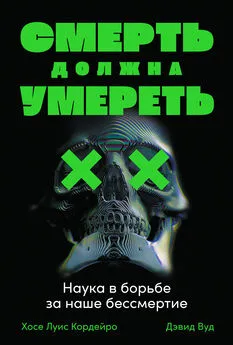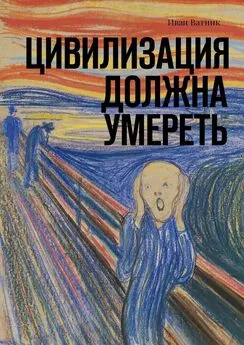Дэвид Вуд - Смерть должна умереть. Наука в борьбе за наше бессмертие
- Название:Смерть должна умереть. Наука в борьбе за наше бессмертие
- Автор:
- Жанр:
- Издательство:Альпина Паблишер
- Год:2021
- Город:Москва
- ISBN:9785961472899
- Рейтинг:
- Избранное:Добавить в избранное
-
Отзывы:
-
Ваша оценка:
Дэвид Вуд - Смерть должна умереть. Наука в борьбе за наше бессмертие краткое содержание
Авторы книги – инженер и ученый Хосе Луис Кордейро и пионер индустрии смартфонов, соучредитель Symbian инженер Дэвид Вуд, возглавляющие международную организацию Humanity+, – утверждают, что примерно к 2045 году в мире будет покончено со смертью от естественных причин. Они уверены, что мы вскоре справимся со всеми смертельными болезнями, а новые технологии позволят излечивать старение как заболевание. Уже через четверть века люди будут выглядеть значительно моложе, чем сейчас.
Опираясь на многолетние исследования, авторы доказывают, что средний возраст человека можно увеличить до 140 лет, сохранив его активность и когнитивные способности. Их книга открывает невероятные перспективы ближайшего будущего человечества без страданий, болезней и преждевременного ухода из жизни.
Смерть должна умереть. Наука в борьбе за наше бессмертие - читать онлайн бесплатно ознакомительный отрывок
Интервал:
Закладка:
Huxley, Julian. (1957). “Transhumanism.” New Bottles for New Wine . Chatto & Windus.
Immortality Institute (ed.). (2004). The Scientific Conquest of Death: Essays on Infinite Lifespans. Libros En Red.
International Monetary Fund. (Anual). World Economic Outlook. International Monetary Fund.
Ioviţă, Anca. (2015). The Aging Gap Between Species. CreateSpace.
Jackson, Moss A. (2016). I Didn’t Come to Say Goodbye! Navigating the Psychology of Immortality. D&L Press.
Kahn, Herman. (1976). The Next 200 Years: A Scenario for America and the World. Quill.
Kaku, Michio. (2018). The Future of Humanity: Terraforming Mars, Interstellar Travel, Immortality, and Our Destiny Beyond Earth. Doubleday.
Kaku, Michio. (2012). Physics of the Future: How Science Will Shape Human Destiny and Our Daily Lives by the Year 2100. Anchor Books.
Kanungo, Madhu Sudan. (1994). Genes and Aging. Cambridge University Press.
Kennedy, Brian K.; Berger, Shelley, L.; Brunet, Anne; Campisi, Judith; Cuervo, Ana Maria; Epel, Elissa S.; Franceschi, Claudio; Lithgow, Gordon J.; Morimoto, Richard I.; Pessin, Jeffrey E.; Rando, Thomas A.; Arlan Richardson, Arlan; Schadt, Eric E.; Wyss-Coray, Tony & Sierra, Felipe. (2014). “Aging: a common driver of chronic diseases and a target for novel interventions.” Cell , 2014 Nov 6; 159(4): pp. 709–713.
Kenyon, Cynthia J. (2010). “The genetics of ageing.” Nature , 464 (7288), pp. 504–512.
Kuhn, Thomas S. (1962). The Structure of Scientific Revolutions. University of Chicago Press.
Kurian, George T. and Molitor, Graham T.T. (1996). Encyclopedia of the Future. Macmillan.
Kurzweil, Ray. (2005). The Singularity Is Near: When Humans Transcend Biology. Viking Press Inc.
Kurzweil, Ray. (1999). The Age of Spiritual Machines. Penguin Books.
Kurzweil, Ray & Grossman, Terry. (2009). TRANSCEND: Nine Steps to Living Well Forever. Rodale Books.
Kurzweil, Ray & Grossman, Terry. (2004). Fantastic Voyage: Live Long Enough to Live Forever. Rodale Books.
Lents, Nathan. (2018). Human Errors: A Panorama of Our Glitches, from Pointless Bones to Broken Genes. Houghton Mifflin Harcourt.
Lieberman, Daniel E. (2013). The Story of the Human Body: Evolution, Health, and Disease. Vintage.
Lima, Manuel. (2014). The book of Trees: Visualizing Branches of Knowledge. Princeton Architectural Press.
Longevity.International. (2017). Longevity Industry Analytical Report 1: The Business of Longevity. Longevity.International.
Longevity.International. (2017). Longevity Industry Analytical Report 2: The Science of Longevity. Longevity.International.
López-Otín, Carlos; Blasco, Maria A.; Partridge, Linda; Manuel Serrano, Manuel & Kroemer, Guido. (2013). “The Hallmarks of Aging.” Cell , 2013 Jun 6; 153 (6): pp. 1194–1217.
Maddison, Angus. (2007). Contours of the World Economy 1–2030 AD: Essays in Macro – Economic History. Oxford University Press.
Maddison, Angus. (2004). Historical Statistics for the World Economy: 1–2003 AD. OECD Development Center.
Maddison, Angus. (2001). The World Economy: A Millennial Perspective. OECD Development Center.
Malthus, Thomas Robert. (2008 [1798]). An Essay on the Principle of Population. Oxford World’s Classics. Oxford University Press.
Martinez, Daniel E. (1998). “Mortality patterns suggest lack of senescence in hydra.” Experimental Gerontology, 1998 May; 33 (3), pp. 217–225.
Martínez-Barea, Juan. (2014). El mundo que viene: Descubre por qué las prо`ximas décadas serán las más apasionantes de la historia de la humanidad. Gestión 2000.
Medawar, Peter. (1952). An Unsolved Problem of Biology. H. K. Lewis.
Mellon, Jim & Chalabi, Al. (2017). Juvenescence: Investing in the Age of Longevity. Fruitful Publications.
Miller, Philip Lee & Life Extension Foundation. (2005). The Life Extension Revolution: The New Science of Growing Older Without Aging. Bantam Books.
Minsky, Marvin. (1994). “Will robots inherit the Earth?” Scientific American, October 1994.
Minsky, Marvin. (1987). The Society of Mind. Simon and Schuster.
Mitteldorf, Josh & Sagan, Dorion. (2016). Cracking the Aging Code: The New Science of Growing Old, and What it Means for Staying Young. Flatiron Books.
Moore, Geoffrey. (1995). Crossing the Chasm: Marketing and Selling High-tech Products to Mainstream Customers. Harperbusiness.
Moravec, Hans. (1999). Robot: Mere Machine to Transcendent Mind. Oxford University Press.
Moravec, Hans. (1988). Mind Children. Harvard University Press.
More, Max. (2003). The Principles of Extropy. Version 3.11. The Extropy Institute.
More, Max & Vita-More, Natasha. (2013). The Transhumanist Reader: Classical and Contemporary Essays on the Science, Technology, and Philosophy of the Human Future. Wiley-Blackwell.
Mulhall, Douglas. (2002). Our Molecular Future: How Nanotechnology, Robotics, Genetics, and Artificial Intelligence will Transform our World. Prometheus Books.
Musi, Nicolas & Hornsby, Peter (ed.). (2015). Handbook of the Biology of Aging, Eight Edition. Academic Press.
Naam, Ramez. (2005). More Than Human: Embracing the Promise of Biological Enhancement. Broadway Books.
Navajas, Santiago. (2016). El hombre tecnolо`gico y el síndrome Blade Runner. Editorial Berenice.
Ocampo, Alejandro; Reddy, Pradeep; Martinez-Redondo, Paloma; Platero-Luengo, Aida; Hatanaka, Fumiyuki; Hishida, Tomoaki; Li, Mo; Lam, David; Kurita, Masakazu; Beyret, Ergin; Araoka, Toshikazu; Vazquez-Ferrer, Eric; Donoso, David; Roman, José Luis; Xu, Jinna; Rodriguez Esteban, Concepcion; Gabriel Nuñez, Gabriel; Nuñez Delicado, Estrella; Campistol, Josep M.; Guillen, Isabel; Guillen, Pedro & Izpisua Belmonte, Juan Carlos. (2016). “In Vivo Amelioration of Age-Associated Hallmarks by Partial Reprogramming.” Cell . 2016, December 15; 167 (7): pp. 1719–1733.
United Nations. (Annual). Statistical Yearbook. United Nations.
Paul, Gregory S. & Cox, Earl. (1996). Beyond Humanity: Cyberevolution and Future Minds. Charles River Media.
Perry, Michael. (2001). Forever For All: Moral Philosophy, Cryonics, and the Scientific Prospects for Immortality. Universal Publishers.
Pickover, Clifford A. (2007). A Beginner’s Guide to Immortality: Extraordinary People, Alien Brains, and Quantum Resurrection. Thunder’s Mouth Press.
United Nations Development Programme. (Annual). Human Development Report. United Nations Development Programme.
Regis, Edward. (1991). Great Mambo Chicken and the Transhuman Condition: Science Slightly over the Edge. Perseus Publishing.
Ridley, Matt. (1995). The Red Queen: Sex and the Evolution of Human Nature. Harper Perennial.
Roco, Mihail C. & Bainbridge, William Sims (eds.). (2003). Converging Technologies for Improving Human Performance. Kluwer.
Rogers, Everett M. (2003). Diffusion of Innovations. 5 thEdition. Free Press.
Rose, Michael. (1991). Evolutionary Biology of Aging. Oxford University Press.
Rose, Michael; Rauser, Casandra L. & Mueller, Laurence D. (2011). Does Aging Stop? Oxford University Press.
Sagan, Carl. (1977). The Dragons of Eden: Speculations on the Evolution of Human Intelligence. Random House.
Serrano, Javier. (2015). El hombre biónico y otros ensayos sobre tecnologías, robots, maquinas y hombres. Editorial Guadalmazán.
Shermer, Michael. (2018). Heavens on Earth: The Scientific Search for the Afterlife, Immortality, and Utopia. Henry Holt and Co.
Simon, Julian L. (1998). The Ultimate Resource 2. Princeton University Press.
Sinclair, David A. (2019). Lifespan: Why We Age – and Why We Don’t Have To. Thorsons.
Stambler, Ilia. (2017). Longevity Promotion: Multidisciplinary Perspectives. CreateSpace Independent Publishing Platform.
Stambler, Ilia. (2014). A History of Life-Extensionism in the Twentieth Century. CreateSpace Independent Publishing Platform.
Stipp, David. (2010). The Youth Pill: Scientists at the Brink of an Anti-Aging Revolution. Current.
Stock, Gregory. (2002). Redesigning Humans: Our Inevitable Genetic Future. Houghton Mifflin Company.
Stolyarov II, Gennady. (2013). Death is Wrong. Rational Argumentators Press.
Strehler, Bernard. (1999). Time, Cells, and Aging. Demetriades Brothers.
Teilhard de Chardin, Pierre. (1964). The Future of Man. Harper & Row.
Venter, J. Craig. (2014). Life at the Speed of Light: From the Double Helix to the Dawn of Digital Life. Penguin Books.
Venter, J. Craig. (2008). A Life Decoded: My Genome: My Life. Penguin Books.
Verburgh, Kris. (2018). The Longevity Code: The New Science of Aging. The Experiment.
Vinge, Vernor. (1993). “The Coming Technological Singularity.” Whole Earth Review , Winter 1993.
Walter, Chip. (2020). Immortality, Inc.: Renegade Science, Silicon Valley Billions, and the Quest to Live Forever. National Geographic.
Warwick, Kevin. (2002). I, Cyborg. Century.
Weindruch, Richard & Walford, Roy. (1988). The Retardation of Aging and Disease by Dietary Restriction. Charles C. Thomas.
Weiner, Jonathan. (2010). Long for This World: The Strange Science of Immortality. HarpersCollins Publishers.
Weismann, August. (1892). Essays Upon Heredity and Kindred Biological Problems. Volumes 1 & 2. Claredon Press.
Wells, H.G. (1902). “The Discovery of the Future.” Nature , 65, pp. 326–331.
West, Michael. (2003). The Immortal Cell. Doubleday.
Wood, David W. (2019). Sustainable Superabundance: A Universal Transhumanist Invitation. Delta Wisdom.
Wood, David W. (2018). Transcending Politics: A Technoprogressive Roadmap to a Comprehensively Better Future. Delta Wisdom.
Wood, David W. (2016). The Abolition of Aging: The forthcoming radical extension of healthy human longevity. Delta Wisdom.
Zhavoronkov, Alex. (2013). The Ageless Generation: How Advances in Biomedicine Will Transform the Global Economy. Palgrave Macmillan.
Zhavoronkov, Alex & Bhullar, Bhupinder. (2015). Classifying aging as a disease in the context of ICD-11. Frontiers in Genetics.
Сноски
1
https://www.visualcapitalist.com/history-of-pandemics-deadliest/.
2
https://www.fightaging.org/archives/2020/08/the-reasons-to-study-aging/.
3
https://www.thelancet.com/infographics/population-forecast.
4
https://www.statista.com/chart/22378/estimated-cost-of-containing-future-pandemic/.
5
http://www.sjayolshansky.com/sjo/Longevity_Dividend_Initative.html.
6
Грей ди О. Отменить старение. – М.: Институт биологии старения, 2011.
7
От лат. Homo sapiens sapiens (человек разумный) – обозначение человеческого подвида, характеризующего современного человека; люди привычного нам анатомического облика.
8
https://www.amazon.com/Immortality-Quest-Forever-Drives-Civilization/dp/1510716157.
9
https://www.amazon.com/Egyptian-Book-Dead-Integrated-Full-Color/dp/1452144389/">https://www.amazon.com/Egyptian-Book-Dead-Integrated-Full-Color/dp/1452144389/.
10
https://www.amazon.com/Epic-Gilgamesh/dp/014044100X">.
11
https://www.amazon.com/First-Emperor-China-Jonathan-Clements-ebook/dp/B00XJIQ7K2/.
Читать дальшеИнтервал:
Закладка:


